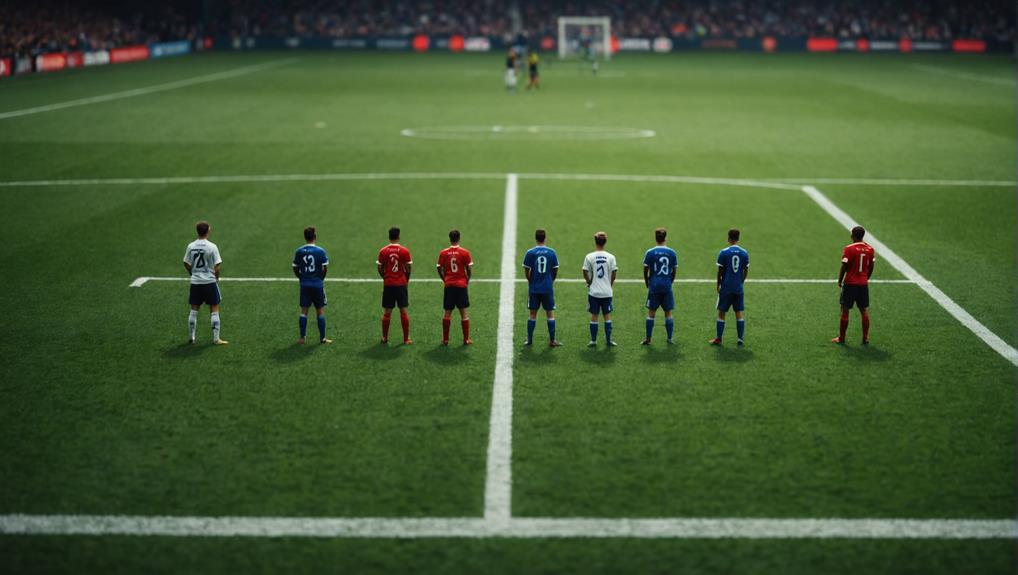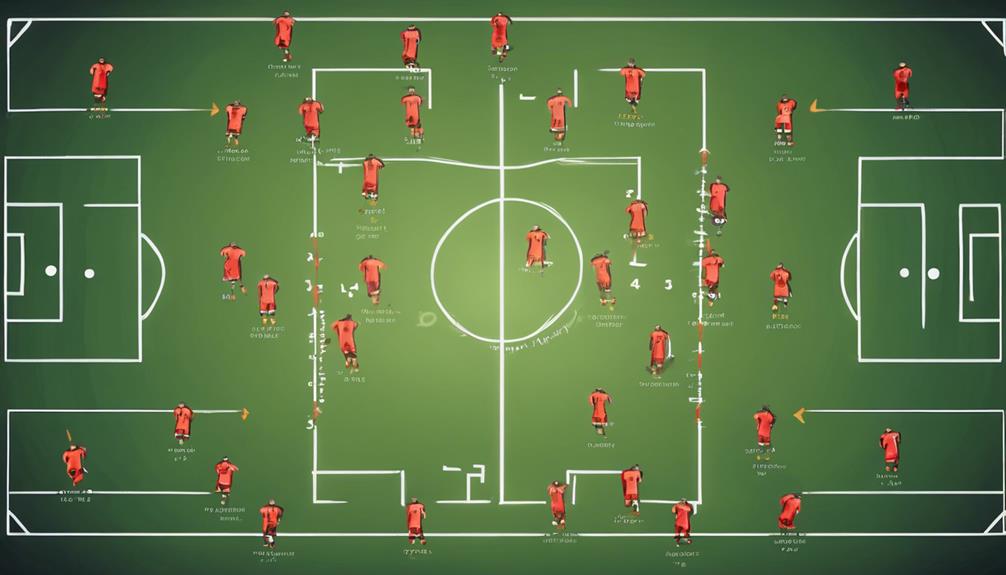
What Is the Best Formation in Soccer? Analyzing the Options
July 25, 2024When deciding on the best soccer formation, consider formations like 4-4-2 or 4-2-3-1 for defensive stability and numerical advantages, enhancing your team structure. The double pivot in a 4-2-3-1 setup bolsters midfield control and dominance, essential for dictating play. Formations such as 4-5-1 emphasize compactness and discipline to thwart opponents effectively. While 3-5-2 and 3-4-3 encourage wide play opportunities, they may expose defensive vulnerabilities. Exploring various tactical adaptations and evolution in formations can offer a deeper understanding of how to optimize your team's performance on the field.
Defensive Stability and Numerical Overloads
For defensive stability and numerical overloads in soccer formations, consider the balance of structures like 4-4-2 and 4-2-3-1. These formations offer a solid defensive foundation while maintaining a structured approach on the field.
The 4-4-2 provides a balanced structure with four defenders, four midfielders, and two forwards, allowing for a cohesive defensive unit and numerical presence in key areas.
On the other hand, the 4-2-3-1 formation places emphasis on a central midfield focus, ensuring control of the middle of the pitch while also providing support to the attack.
Double Pivot and Midfield Dominance
Consider the pivotal role of the double pivot in midfield for achieving midfield dominance in soccer formations.
The 4-2-3-1 formation is renowned for its utilization of a double pivot, providing teams with a solid defensive cover while also establishing a strong central presence. This setup enables teams to dictate play by overwhelming the midfield with numerical superiority.
With two holding midfielders, the double pivot not only guarantees defensive stability but also allows for a swift switch to attack through the central midfield. Teams employing a double pivot can effectively control the tempo of the game, exploiting gaps in the opponent's midfield through well-coordinated movements.
The 4-2-3-1 formation's double pivot offers versatility in both defensive and offensive changes, making it a popular choice for those seeking midfield dominance. By mastering the double pivot, teams can enhance their ability to transition swiftly, maintain control of the midfield, and ultimately dominate the flow of the game.
Emphasis on Compactness and Solidity

Emphasizing compactness and solidity in soccer formations is key to maintaining a strong defensive shape and limiting space for opponents to exploit. Formations like the 4-4-2 and 4-5-1 are known for their defensive emphasis, prioritizing compactness to thwart attacks effectively. These setups focus on disciplined defending, ensuring that there are fewer gaps for the opposition to exploit.
Similarly, the 5-3-2 formation also places a significant emphasis on compactness, with five defenders forming a solid defensive block to deny the opponent space and opportunities. Teams utilizing such formations aim to stay organized, making it challenging for the opposition to break them down.
Wide Play and Vulnerabilities
Wide play in soccer formations can provide attacking opportunities but also presents vulnerabilities that teams must address strategically. When examining formations with a focus on wide play, such as 3-5-2 or 3-4-3, it's essential to comprehend the potential weaknesses that come with emphasizing the flanks.
Here are some key points to contemplate:
- Formations like 3-5-2 utilize wing-backs for width but can be exposed in wide areas defensively.
- The 3-4-3 setup may offer attacking threats through wide forwards, but it can lead to a lack of central presence in midfield.
- Wide play in systems like 3-5-2 can result in numerical advantages in the final third but leave gaps in the midfield for opponents to exploit.
Challenges Across Formations

You face challenges across formations when analyzing vulnerabilities and tactical considerations.
Understanding the demands on wing-backs and weaknesses in wide spaces is essential for strategic planning.
Analyzing formation vulnerabilities and wing play considerations provides valuable insights for optimizing your team's performance.
Formation Vulnerabilities Analysis
Analyzing the vulnerabilities present in different soccer formations reveals key challenges teams face across various strategic setups. When considering formations, vulnerabilities in wide areas are a common theme, leaving teams exposed to attacks from the flanks.
The demands placed on versatile and fit wing-backs are heightened due to the expansive spaces they must cover in a range of formations. Tactical analysis often uncovers weaknesses in midfield presence, particularly when wide forwards push forward in setups like the 3-4-3 formation.
Moreover, formations such as the 3-5-2 may provide width through wing-backs but can leave vulnerabilities in central areas, allowing opponents opportunities to exploit gaps. Reduced midfield presence poses a significant challenge in formations emphasizing wide wing play, impacting both control and defensive stability.
Wing Play Considerations
Considering the strategic implications of wing play in soccer formations reveals key challenges that teams must address for effective gameplay. Wide play in formations like 3-5-2 and 3-4-3 offers attacking width but can leave central areas vulnerable, requiring defensive cover.
While 3-5-2 provides extra numbers in the final third, it demands careful consideration to prevent wide spaces from being exploited. Similarly, in a 3-4-3 setup, the advancement of wide forwards can impact central access, affecting the team's overall balance.
In contrast, formations such as 4-4-2 prioritize defensive solidity, but if wing players fail to track back effectively, wide spaces become a point of concern. To achieve successful gameplay, teams must find the right balance between utilizing wing players for attacking width and ensuring sufficient defensive cover to mitigate vulnerabilities in wide areas.
Strategic adjustments and player roles play a pivotal role in overcoming the challenges associated with wing play across different formations.
Data Analysis and Performance Metrics
Performance metrics play an essential role in soccer through data analysis, providing valuable insights into player contributions and areas for improvement. When analyzing player performance, teams rely on various metrics such as passing accuracy, distance covered, and shots on target. These metrics help evaluate how players are performing on the field and pinpoint areas where they can enhance their game. Utilizing data analysis allows teams to make informed decisions regarding player selection, tactical adjustments, and game strategies.
Moreover, advanced analytics go beyond basic statistics, revealing player tendencies, opponent weaknesses, and overall team performance trends. By leveraging data-driven approaches, teams can enhance their training programs, optimize player development, and ultimately boost their competitiveness on the field.
- Data analysis tracks player performance metrics like passing accuracy and shots on target.
- Performance metrics aid in evaluating player contributions and identifying areas for improvement.
- Teams use data analysis to make informed decisions on player selection, tactical adjustments, and game strategies.
Impact of Technology on Analysis

Technology has transformed soccer analysis by providing detailed player statistics and advanced analytics tools. Video analysis software offers in-depth insights into game strategies and player performances, allowing coaches and analysts to make more informed decisions.
GPS tracking systems have revolutionized player management by monitoring physical performance metrics such as distance covered, speed, and heart rate during training and matches. Virtual reality tools have enhanced tactical training sessions, enabling teams to simulate game scenarios and strategize effectively.
Interactive experiences driven by technology have greatly boosted fan engagement, offering immersive ways for supporters to connect with the sport and enhancing the overall soccer analysis experience. With advancements in technology continuing to shape the landscape of soccer analysis, teams are gaining a competitive edge through data-driven insights and innovative tools that optimize player performance and fan interaction.
Evolution of Soccer Formations
Let's take a closer look at how soccer formations have evolved over time and the tactical adaptations that have shaped the game.
Understanding the historical shifts in formations can provide valuable insight into the strategic decisions made by teams on the field.
Analyzing these changes offers a fascinating glimpse into the ever-evolving landscape of soccer tactics.
Formation Evolution Overview
Over time, soccer formations have undergone a significant evolution from traditional structures to more modern and tactical setups. This evolution has led to the rise of formations like the 4-2-3-1, which emphasize defensive solidity, tactical flexibility, and a balance between defense and attack.
The shift towards modern formations has enabled teams to exploit opponents' weaknesses more effectively, leading to more strategic gameplay on the field.
Modern Formations: Emphasize balance between defense and attack.
4-2-3-1: Known for defensive solidity and creativity in midfield.
Tactical Flexibility: Variations like 4-3-3 and 3-5-2 offer diverse tactical options.
Exploit Opponents' Weaknesses: Constant adaptation in formations allows teams to capitalize on their rivals' vulnerabilities.
Tactical Adaptations Analysis
Analyzing the evolution of soccer setups reveals a strategic shift towards modern configurations that prioritize both defensive stability and attacking creativity. Tactical adaptations have played a pivotal role in shaping these modern setups, with teams seeking a balance between defensive solidity and attacking prowess.
For example, formations like the 4-2-3-1 and 4-3-3 have gained popularity due to their emphasis on possession and offensive capabilities.
In the evolution of setups, key considerations revolve around finding ways to maintain a solid defensive structure while unleashing attacking creativity. Setups such as the 3-5-2 have emerged to provide unique defensive arrangements with three center backs and wing backs offering width in attack.
Constant adaptation is essential to ensure that setups remain effective in shaping teams' potential and impacting the dynamics of the game significantly.
Player Recruitment Strategies

Global talent identification in soccer heavily relies on scouting databases for implementing effective player recruitment strategies. Utilizing statistical analysis is essential in the modern game as it aids in shortlisting potential signings based on performance data.
Data-driven recruitment has become a cornerstone in reducing transfer risks and enhancing team building efforts. Tailoring player profiles to match team requirements is a key aspect of successful recruitment strategies, ensuring that new additions complement the existing squad seamlessly.
Analytics play a pivotal role in uncovering undervalued players who might otherwise go unnoticed, allowing clubs to make informed decisions when bolstering their squads. By leveraging these tools and methods, teams can optimize their recruitment processes and secure players who not only have the right skill set but also align with the overall team vision.
Conclusion
So, when it comes to choosing the best formation in soccer, it ultimately depends on the strengths and weaknesses of your team.
However, data shows that teams with a 4-3-3 formation have achieved the highest average possession percentage in recent seasons, indicating a focus on controlling the midfield and dictating play.
Consider this statistic when deciding on the formation that best suits your team's style of play.


